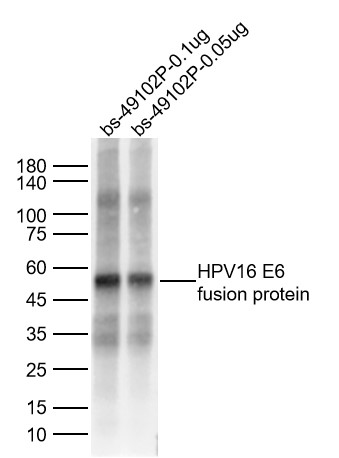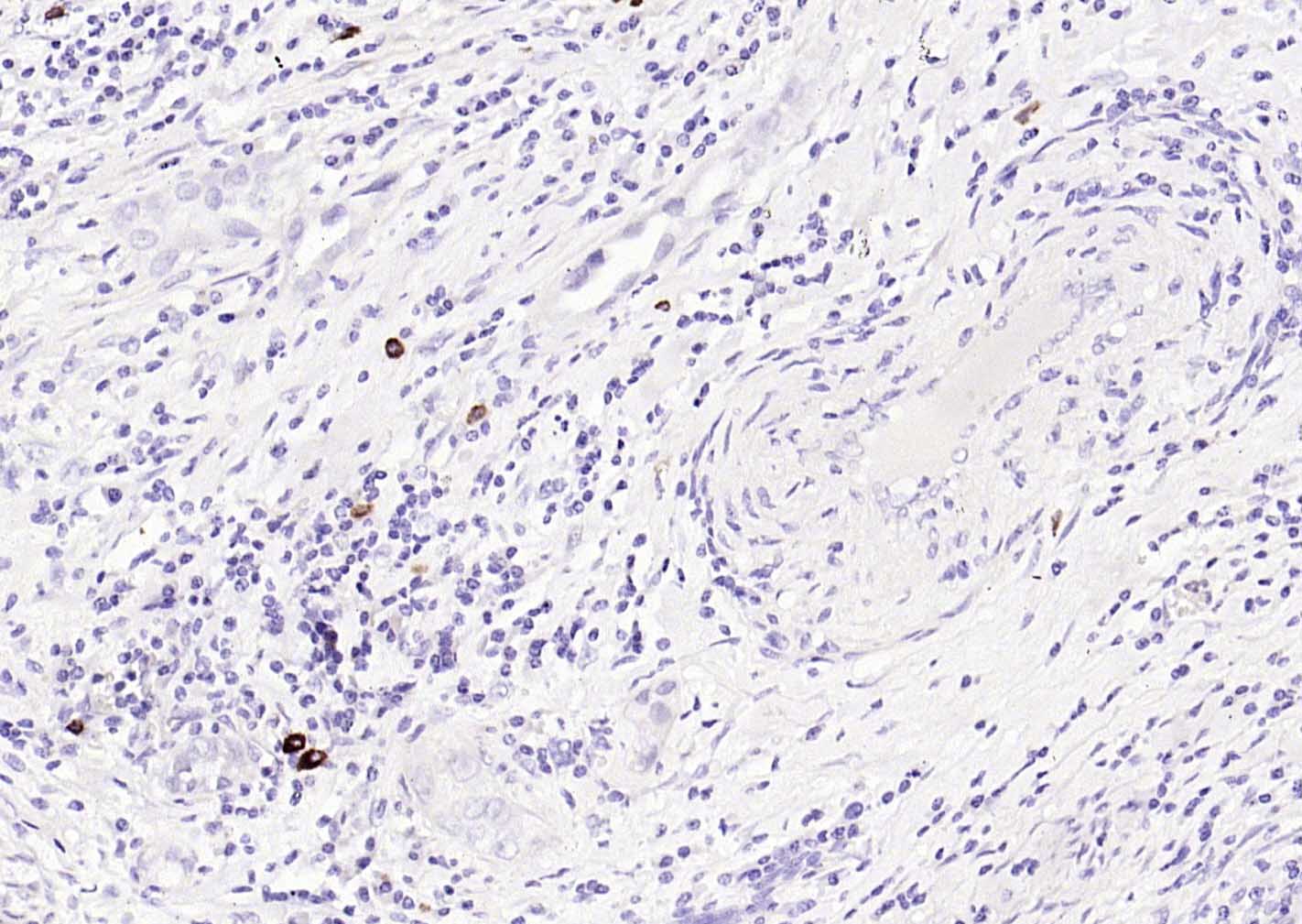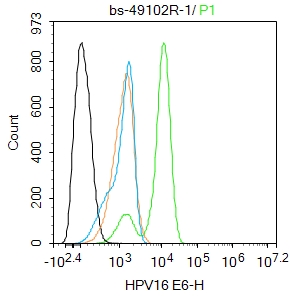
Rabbit Anti-HPV16 E6 antibody
E6; HPV16 E6 protein; Human Papilloma Virus; Human papillomavirus type 16 E6; Human papillomavirus type 16; Protein E6; E6 protein; HPV16 E6; HPV16-E6; VE6_HPV16.
View History [Clear]
Details
Product Name HPV16 E6 Chinese Name 人类乳头状瘤病毒16抗体 Alias E6; HPV16 E6 protein; Human Papilloma Virus; Human papillomavirus type 16 E6; Human papillomavirus type 16; Protein E6; E6 protein; HPV16 E6; HPV16-E6; VE6_HPV16. Research Area Tumour Bacteria and viruses Immunogen Species Rabbit Clonality Polyclonal React Species Human, Applications WB=1:500-2000 Flow-Cyt=1ug/Test
not yet tested in other applications.
optimal dilutions/concentrations should be determined by the end user.Theoretical molecular weight 11kDa Form Liquid Concentration 1mg/ml immunogen Recombinant HPV16 E6 Lsotype IgG Purification affinity purified by Protein A Buffer Solution 0.01M TBS(pH7.4) with 1% BSA, 0.03% Proclin300 and 50% Glycerol. Storage Store at -20 °C for one year. Avoid repeated freeze/thaw cycles. The lyophilized antibody is stable at room temperature for at least one month and for greater than a year when kept at -20°C. When reconstituted in sterile pH 7.4 0.01M PBS or diluent of antibody the antibody is stable for at least two weeks at 2-4 °C. Attention This product as supplied is intended for research use only, not for use in human, therapeutic or diagnostic applications. PubMed PubMed Product Detail Human papilloma viruses (HPVs) can be classified as either high risk or low risk according to their association with cancer. HPV16 and HPV18 are the most common of the high risk group while HPV6 and HPV11 are among the low risk types. Approximately 90% of cervical cancers contain HPV DNA of the high risk types. Mutational analysis have shown that the E6 and E7 genes of the high risk HPVs are necessary and sufficient for HPV transforming function. The specific interactions of the E6 and E7 proteins with p53 and pRB, respectively, correlate with HPV high and low risk classifications. The high risk HPV E7 proteins bind to pRB with a higher affinity than do the low risk HPV proteins, and only the high risk HPV E6 proteins form detectable complexes with p53 in vitro.
Function:
Plays a major role in the induction and maintenance of cellular transformation. Acts mainly as an oncoprotein by stimulating the destruction of many host cell key regulatory proteins. E6 associates with host E6-AP ubiquitin-protein ligase, and inactivates tumor suppressors TP53 and TP73 by targeting them to the 26S proteasome for degradation. In turn, DNA damage and chromosomal instabilities increase and lead to cell proliferation and cancer development. The complex E6/E6P targets several other substrates to degradation via the proteasome including host NFX1-91, a repressor of human telomerase reverse transcriptase (hTERT). The resulting increased expression of hTERT prevents the shortening of telomere length leading to cell immortalization. Other cellular targets including Bak, Fas-associated death domain-containing protein (FADD) and procaspase 8, are degraded by E6/E6AP causing inhibition of apoptosis. E6 also inhibits immune response by interacting with host IRF3 and TYK2. These interactions prevent IRF3 transcriptional activities and inhibit TYK2-mediated JAK-STAT activation by interferon alpha resulting in inhibition of the interferon signaling pathway.
Subunit:
Forms a complex E6-AP ubiquitin-protein ligase which interacts with human TP53. Binds to human FBLN1 and MPDZ (By similarity). Interacts with human NFX1 and MAGI3. Interacts with human IRF3; this interaction inhibits the establishment of antiviral state. Interacts with human TYK2; this interaction inhibits JAK-STAT activation by interferon alpha.
Subcellular Location:
Host nucleus matrix.
Similarity:
Belongs to the papillomaviridae E6 protein family.
SWISS:
P03126
Gene ID:
1489078
Database links:Entrez Gene: 1489078 HPV16 E6
Product Picture
Lane 1: HPV16 E6 fusion protein (SL49102P) 0.1ug Lysates
Lane 2: HPV16 E6 fusion protein (SL49102P) 0.05ug Lysates
Primary: Anti-HPV16 E6 (SL49102R) at 1/1000 dilution
Secondary: IRDye800CW Goat Anti-Rabbit IgG at 1/20000 dilution
Predicted band size: 11kDa
Observed band size: 50kDa
Paraformaldehyde-fixed, paraffin embedded (human cervical carcinoma); Antigen retrieval by boiling in sodium citrate buffer (pH6.0) for 15min; Block endogenous peroxidase by 3% hydrogen peroxide for 20 minutes; Blocking buffer (normal goat serum) at 37°C for 30min; Incubation with (HPV16 E6) Polyclonal Antibody, Unconjugated (SL49102R) at 1:200 overnight at 4°C, followed by operating according to SP Kit(Rabbit) (sp-0023) instructionsand DAB staining.Blank control(black line):Hela.
Primary Antibody (green line): Rabbit Anti-HPV16 E6 antibody (SL49102R)
Dilution:1ug/Test;
Secondary Antibody(white blue line): Goat anti-rabbit IgG-AF488
Dilution: 0.5ug/Test.
Isotype control(orange line): Normal Rabbit IgG
Protocol
The cells were fixed with 4% PFA (10min at room temperature)and then permeabilized with 90% ice-cold methanol for 20 min at -20℃, The cells were then incubated in 5%BSA to block non-specific protein-protein interactions for 30 min at room temperature .Cells stained with Primary Antibody for 30 min at room temperature. The secondary antibody used for 40 min at room temperature. Acquisition of 20,000 events was performed.
References (0)
No References
Bought notes(bought amounts latest0)
No one bought this product
User Comment(Total0User Comment Num)
- No comment





 +86 571 56623320
+86 571 56623320
 +86 18668110335
+86 18668110335

